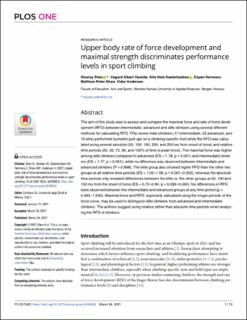| dc.contributor.author | Stien, Nicolay | |
| dc.contributor.author | Vereide, Vegard Albert | |
| dc.contributor.author | Sæterbakken, Atle Hole | |
| dc.contributor.author | Hermans, Espen | |
| dc.contributor.author | Shaw, Matthew Peter | |
| dc.contributor.author | Andersen, Vidar | |
| dc.date.accessioned | 2021-08-26T07:51:37Z | |
| dc.date.available | 2021-08-26T07:51:37Z | |
| dc.date.created | 2021-07-08T10:12:40Z | |
| dc.date.issued | 2021 | |
| dc.identifier.citation | Stien, N., Vereide, V. A., Saeterbakken, A. H., Hermans, E., Shaw, M. P., & Andersen, V. (2021). Upper body rate of force development and maximal strength discriminates performance levels in sport climbing. Plos One, 16(3). | en_US |
| dc.identifier.issn | 1932-6203 | |
| dc.identifier.uri | https://hdl.handle.net/11250/2771323 | |
| dc.description.abstract | The aim of this study was to assess and compare the maximal force and rate of force development (RFD) between intermediate, advanced and elite climbers using several different methods for calculating RFD. Fifty-seven male climbers (17 intermediate, 25 advanced, and 15 elite) performed isometric pull-ups on a climbing-specific hold while the RFD was calculated using several absolute (50, 100, 150, 200, and 250 ms from onset of force) and relative time periods (25, 50, 75, 95, and 100% of time to peak force). The maximal force was higher among elite climbers compared to advanced (ES = 1.78, p < 0.001) and intermediate climbers (ES = 1.77, p < 0.001), while no difference was observed between intermediate and advanced climbers (P = 0.898). The elite group also showed higher RFD than the other two groups at all relative time periods (ES = 1.02–1.58, p < 0.001–0.002), whereas the absolute time periods only revealed differences between the elite vs. the other groups at 50, 100 and 150 ms from the onset of force (ES = 0.72–0.84, p = 0.032–0.040). No differences in RFD were observed between the intermediate and advanced groups at any time period (p = 0.942–1.000). Maximal force and RFD, especially calculated using the longer periods of the force curve, may be used to distinguish elite climbers from advanced and intermediate climbers. The authors suggest using relative rather than absolute time periods when analyzing the RFD of climbers. | en_US |
| dc.language.iso | eng | en_US |
| dc.publisher | PLOS | en_US |
| dc.rights | Navngivelse 4.0 Internasjonal | * |
| dc.rights.uri | http://creativecommons.org/licenses/by/4.0/deed.no | * |
| dc.subject | climbing | en_US |
| dc.subject | anthropometry | en_US |
| dc.subject | elbow | en_US |
| dc.subject | sports | en_US |
| dc.subject | computer software | en_US |
| dc.subject | hands | en_US |
| dc.subject | muscle analysis | en_US |
| dc.subject | shoulders | en_US |
| dc.title | Upper body rate of force development and maximal strength discriminates performance levels in sport climbing | en_US |
| dc.type | Peer reviewed | en_US |
| dc.type | Journal article | en_US |
| dc.description.version | publishedVersion | en_US |
| dc.rights.holder | © 2021 Stien et al. | en_US |
| dc.source.volume | 16 | en_US |
| dc.source.journal | PLOS ONE | en_US |
| dc.source.issue | 3 | en_US |
| dc.identifier.doi | 10.1371/journal.pone.0249353 | |
| dc.identifier.cristin | 1920938 | |
| cristin.ispublished | true | |
| cristin.fulltext | original | |
| cristin.qualitycode | 1 | |

